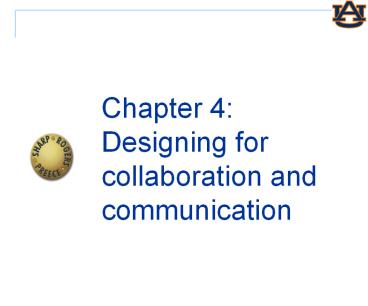Chapter 4: Designing for collaboration and communication - PowerPoint PPT Presentation
Title:
Chapter 4: Designing for collaboration and communication
Description:
Users take part by 'dressing up' as an avatar, including penguins and real people. Once an avatar has entered a world they can explore it and chat to other avatars ... – PowerPoint PPT presentation
Number of Views:379
Avg rating:3.0/5.0
Title: Chapter 4: Designing for collaboration and communication
1
Chapter 4 Designing for collaboration and
communication
2
Overview
- What is communication?
- Conversational mechanisms
- Coordination mechanisms
- Awareness mechanisms
- Examples of technologies designed to extend how
people - talk and socialise
- work together
- play and learn together
3
What is communication?
- Along with intelligence ,communication is the one
which gives us edge from other animals. - It is a mean of transferring knowledge.
- Language is a tool of communication.
- Invention of printing press was the greatest
single discovery in the field of communication
before internet.
4
Social communication
- Verbal communication.
- Face to face.
- Over phone.
- Voice chat and Video Conferencing.
- Non-verbal communication.
- Mails.
- Emails.
- Instant Messenger
- Text messaging.
(Video).
5
Conversational mechanisms
- Various mechanisms and rules are followed when
holding a conversation, e.g. mutual greetings - A Hi there
- B Hi!
- C Hi
- A All right?
- C Good, hows it going?
- A Fine, how are you?
- C OK
- B So-so. Hows life treating you?
6
Conversational mechanism cont..
- Turn-taking used to coordinate conversation
- A Shall we meet at 8?
- B Um, can we meet a bit later?
- A Shall we meet at 8?
- B Wow, look at him?
- A Yes what a funny hairdo!
- B Um, can we meet a bit later?
- Back channelling to signal to continue and
following - Uh-uh, umm, ahh
7
Conversational mechanism cont..
- farewell rituals
- Bye then, see you, see you later.
- implicit and explicit cues
- e.g., looking at watch, fidgeting with coat and
bags - explicitly saying Oh dear, must go, look at the
time, Im late
8
Conversational rules
- Sacks et al. (1978) work on conversation analysis
describe three basic rules - Rule 1 the current speaker chooses the next
speaker by asking an opinion, question, or
request - Rule 2 another person decides to start speaking
- Rule 3 the current speaker continues talking
9
Breakdowns in conversation
- When someone says something that is
misunderstood - Speaker will repeat with emphasis
- A this one?
- B no, I meant that one!
- Also use tokens
- Eh? Quoi? Huh? What?
10
What happens in technology-mediated conversations?
- Do same conversational rules apply?
- Are there more breakdowns?
- How do people repair them for
- Phone?
- Email?
- IM?
- Text Messaging?
11
Designing collaborative technologies
- Challenges confronting the designers is to
consider how to facilitate different kinds of
communication where there are obstacles
preventing it from happening naturally.
12
- The main aim is to develop systems that allow
people to communicate with each other when they
are in physically different locations. - The key issue is how to allow people to carry on
communicating as if they are in same place. - How to design collaborative technologies to help
co-located groups to communicate.
13
Communicating in physically different locations
- Video Example
- Emails, Videoconferencing,
- Videophones, Computer Conferencing, Chat rooms
and IM. - Online MUDs and MOOs (text based) were created to
allow users communicate exclusively using text.
14
Activity how do the conversations differ for the
same game of ZORKI?
15
3D virtual worlds
The rooftop garden in BowieWorld Users take
part by dressing up as an avatar, including
penguins and real people Once an avatar has
entered a world they can explore it and chat to
other avatars Source www.worlds.com/bowie
16
Massive 3D virtual worlds
- Second Life (2003)
- Over 2 million users
- Habbo Hotel (2000)
- Over 7 million players
- Massively multiplayer online game
- What kinds of conversation take place in these
environments?
17
Media spaces
- They combine audio,video and computer systems to
extend the world of desks,chairs,walls ad
ceilings. - Example
- Xerox Media Space, Hydra, Cruiser and Video
window system.
18
A typical media space node
19
Sketch of VideoWindow































